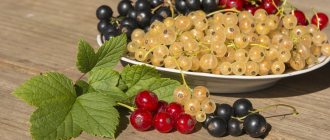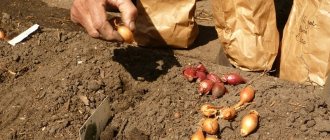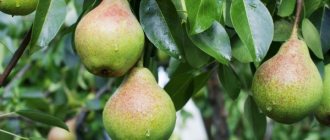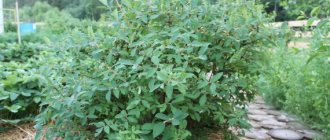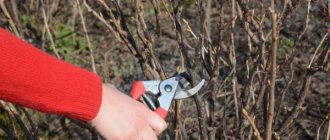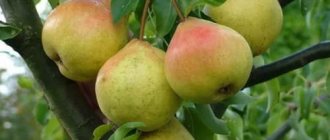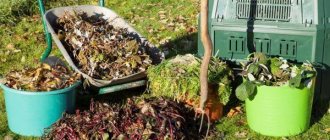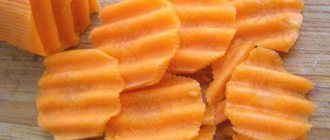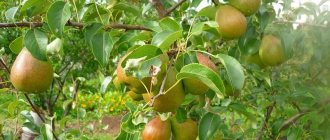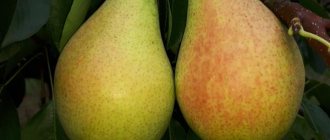Pruning mature fruit trees
Your garden is already bearing fruit. But it, like young trees, requires care and removal of dried or diseased branches. How to properly prune fruit trees in spring?
The thickened crown of a fruit tree needs to be thinned out. After five years, the conductor is removed. This will limit upward growth. Remove the branch completely or partially. Partial removal will promote the growth of the branch that is located nearby. It is also necessary to cut off diseased, dried branches - the illumination of the crown improves, the fruits are distributed evenly.
Pruning is best done when the tree is dormant, before sap flow begins.
If the crown is pyramidal (pear - branches grow upward), the growing branches need to be lowered down: those that are directed downward are left, and those that are directed upward are cut off. In other fruit trees, the branches are directed downwards - they need to be lifted: remove the ones pointing downwards.
To rejuvenate a tree, you will need to cut out the upper part of the trunk and thin out the crown. To do this, you should remove the old branches going inside the crowns that are intertwined. A very dense crown should not be thinned out overnight, so as not to seriously injure the plant; spread out the operation over two to three years.
Pruning an apple tree for beginners - what should be removed first:
· Dried and broken branches;
· One of the closely located branches is weaker;
· Vertically located fatty shoots - tops;
· Branches growing at an acute angle.
More rules for beginners
You need to cut it into a ring.
The knife and saw must be sharp.
If part of a branch is removed, cut above a strong bud.
There is some debate about the need to treat cuttings, but when pruning in spring, treating with a fungicidal paste is more advisable than not.
Popular beginner mistakes
Pruning fruit trees requires a special approach and some skills. Therefore, when shortening branches, novice gardeners often make the following mistakes:
- Too early pruning in spring. In the southern regions, the formation of the pear crown can begin at the very beginning of March, but for northern areas such periods are unacceptable, since at such a time it falls before the start of sap flow. Very early removal of branches causes poor healing of the cuts.
- Use blunt hacksaws to remove large branches. Pruning thick branches must be done with special tools that have a thin blade and a sharp row of teeth. Removing shoots with devices unsuitable for these purposes results in the formation of equal cut edges. The consequence of such shortening is the appearance of fungus and the formation of a hollow.
- Cutting a branch at an acute angle. Such removal of the shoot is incorrect and often causes cracking or peeling of the formed branch from the trunk. The optimal cutting angle is considered to be at least 45 degrees.
- A large number of pruned branches at one time. Even the most neglected crowns of fruit trees must be cleared in stages. A large number of branches removed during a season can lead to a halt in the development of the crown and weaken the tree.
Regular formation of the pear crown allows you to grow a healthy tree with strong branches. When carrying out the procedure, you should always take into account the age of the fruit plant and its condition. A high-quality and stable harvest can only be obtained with proper pruning.
How to prune an apple tree correctly?
Before properly pruning an apple tree, you need to carefully study pruning methods and their types.
Types of pruning
Pruning can be formative, sanitary, rejuvenating and regulating. Formative pruning creates a strong skeleton for the tree, on which only strong, fruit-bearing branches remain. Sanitary pruning is designed to clean the tree from damaged and incorrectly growing branches.
Rejuvenation - removal of old fruit branches. With the help of regulatory pruning, the height of the apple tree is restrained, the crown is thinned, and fruiting is regulated.
Based on intensity, pruning methods are divided into pinching, weak, medium and strong.
- Pinching is used during the active development of annual green growths.
- With light pruning on young trees, the growth of new shoots is stimulated; skeletal branches are cut by one quarter.
- With medium pruning, branches are cut by one third. This method is used on mature apple trees that are more than five years old.
- Heavy pruning involves the complete removal of a large number of branches. This is how the crowns of mature trees are thinned out.
Trimming to ring
This technique is used when you want to completely delete a branch. At the point of growth, each branch has a ring-shaped growth.
In this place, tissue cells are able to actively divide, so a cut made into a ring heals quickly
It is important to make an even, clean cut so that approximately half of the ring remains on the branch and half on the base
You cannot cut too far from the base - a stump will remain. The consequence of such pruning is that the stump dries out, falls out and forms a hollow. You cannot completely cut off the ring from the base, going deeper into the cambium - this will injure the tree.
Bud pruning
When branches are partially removed, pruning to the outer bud allows you to expand the crown and reduce its density.
A cut to a bud looking inside the crown is used so that the shoots begin to grow inward and the crown becomes dense.
The correct cutting distance is no more than 50mm from the selected bud. Exceed this distance and a stump will remain; if it is too low, there is a risk of kidney damage.
The cuts should be immediately covered with garden varnish, oil paint or drying oil to prevent infection from damaging the wound.
An example of correct pruning for a bud.
It is better to pre-disinfect large annular areas with antifungal drugs, for example, a solution of copper sulfate or iron sulfate (three or five%, respectively).
How to prune a pear in the fall: diagrams and tips for beginner gardeners
Formative and sanitary pruning of pear trees depends not only on the time of year, but also on the age and type of tree. An incorrect plan for removing branches or an error in choosing the timing can lead to a decrease in the yield of an adult pear tree or its death.
Beginners will be helped to properly prune pears by advice from experienced gardeners:
- For the event, sharpened instruments are used.
- Wounds will heal faster if you cut the growth into a ring.
- Large branches must be removed in several stages, dividing the procedure by season.
- When pruning with pruning shears, the blade should be facing the shoot.
- The sections are treated with garden varnish or special disinfectants for trees.
Some gardeners use a gentle method to remove excess growth. To do this, use a thin steel wire to pull the branch at a given height. After some time, the metal thread will cut off part of the branch without damaging the rest of the tree.
Pruning a young pear in autumn
When planting a one-year-old seedling, it is necessary to shorten the trunk at a height of 60 to 90 cm in the fall. This will speed up the development of the root system.
If the growth of the tree is not limited in the first year of development, the main load-bearing branches will form too high, which will make it difficult to collect fruit in the future. Too low a pear crown will interfere with tree care.
Rules for pruning pears in autumn in pictures for beginners:
Pruning is carried out with a sharp pruner or knife over the bud.
How to prune a two-year-old pear tree in the fall
A tree that has overwintered in open ground is considered biennial. The trunk (conductor) has 8 - 10 lateral shoots, from which the skeletal branches of the future adult tree should be formed.
Only half of the branches are left for normal development. They should be evenly distributed around the circumference at different heights. It is necessary to leave those branches that are located at an angle of about 50 degrees in relation to the trunk. A tighter fit poses the risk of splitting in strong winds.
Excess shoots are cut into a ring, leaving no stumps. The remaining ones are shortened by a quarter of the length to the upper outer bud. With proper pruning, the buds are located at different heights.
Eventually:
- All skeletal branches should be arranged in increasing length from bottom to top. The lower the branch grows, the shorter it should be in relation to the upper ones.
- The conductor should rise no more than a quarter of a meter above the upper branches.
- It is necessary to cut out competing shoots (they grow at an acute angle to the trunk).
After pruning, it is necessary to exclude nitrogenous compounds from fertilizing, otherwise the plant will increase the growth of greenery, instead of the necessary healing of wounds.
How to prune a three-year-old pear tree in the fall
The older the pear, the more carefully you have to monitor the correct formation of the crown. Pruning of a three-year-old tree differs from previous years only in scale.
Scheme for pruning pears in autumn by year:
Algorithm of actions:
- Remove branches that compete with the explorer.
- Trim shoots that grow incorrectly at a right and too sharp angle to the trunk.
- Shorten all others by a quarter of the annual growth.
- Remove root growth.
- Eliminate tops (upright growth on a branch and trunk).
Scheme for pruning tops on a pear in the fall:
How to rejuvenate an old pear tree in the fall
Pear trees 8 years old and older need rejuvenating pruning. By this time, the crown of the plant is usually too thick, although the growth rate of young branches decreases. It is necessary to prune an old pear in the fall to improve aeration and stimulate the development of new fruit branches. Due to the scale, cutting is carried out in several stages, evenly distributed over the seasons.
First of all, old and dried branches are eliminated. Branches that compete with the conductor are cut off.
Large branches inside the crown are removed up to two or three buds, leaving a replacement knot on which the next fruiting branch will develop. A branch is considered large if its diameter exceeds the conductor by about half.
Important! No more than three large branches are cut at a time so that the pear does not suffer.
Lastly, they work with incorrectly grown branches, shortening the annual growth by a quarter.
It is better to start the rejuvenating procedure of pruning an old pear in the fall according to the scheme after a lean year in the spring, and carry out the second stage in the fall.
Features of pruning columnar pears in autumn
The pruning scheme for columnar pears is slightly different from working with other varieties. In the fall, sanitary pruning is carried out. Remove old and drying shoots. “Idle” branches that have not formed flower buds are pruned, but at the same time they take away nutrients from the tree.
In the first year of life, the main trunk is shortened at a height of about half a meter from the soil level. The cut is made on the bud, which is located on the opposite side of the graft. Every year the trunk of the columnar pear is shortened, leaving no more than 20 cm above last year’s shoots.
Slow branch growth is a distinctive feature of columnar varieties. Therefore, only by the fourth year does the pear have a sufficient number of branches, from which a fruit-bearing crown is formed.
To do this, leave no more than half of the strongest branches located around the trunk at the same level, and the rest are cut into a ring to avoid the appearance of tops. Every year the branches and trunk are shortened to ensure the growth of fresh fruit shoots.
How to prune a dwarf pear in the fall
Dwarf pear varieties were developed relatively recently, but despite this, they quickly won the love of gardeners. The work required to care for small bushes is much less than when growing tall species. And it is much easier to protect a small pear from frost, which is especially important for cold regions.
Pruning of a dwarf pear must be carried out in the first years of its development. After planting, the seedling is cut at a height of about half a meter. In the second and third years, it is enough to shorten the side branches and cut off the conductor, leaving up to 20 cm of growth. Already in the third year, up to 5 - 6 strong skeletal branches should appear in the crown of the dwarf variety, on which fruit branches will begin to develop. Subsequently, pruning is carried out for sanitary purposes, removing damaged branches and root shoots.
Types of pruning
When carrying out the pear pruning procedure in the fall, different types are used, aimed at the correct formation of the crown. Depending on the intended goals, they may be:
- Shortening. If the direction of growth of the branches is vertical, they should be removed, and annual shoots should also be shortened. Thanks to this approach, horizontal branching is activated and the upper shoots do not grow so quickly. The yield decreases slightly, but the quality of the fruit and its size increase.
- Thinning. With this option, the entire shoots are removed, and they are cut off at the base of the trunk or mother branch. The procedure is aimed at giving more light inside the crown. Thanks to this, the shoots grow better, there are more leaves, the yield increases, and the immunity of the pear increases. There is also an optimal redistribution of nutrients, which has a positive effect on the formation of fruit branches.
- Formation. The method is primarily aimed at creating a crown of the desired shape and ensuring the growth of fruit-bearing branches. Forming begins from the moment the seedling is planted and continues for 5 years. At the same time, they try to remove smaller shoots before fruiting begins.
- Support. This type of pruning is carried out on pears that have already entered the fruiting season. Its purpose is to properly distribute nutrition throughout the tree and stabilize fruiting.
- Rejuvenation. This operation is designed to increase the life of the pear and its fruiting period. After pruning, new shoots begin to actively grow, and the quality and quantity of the harvest also increases. The procedure is used for trees that have lived for 30 years or more.
The above pruning options are used quite widely, but in addition to them there are other techniques:
- bending to change the direction of shoot growth;
- tying branches;
- kerbovka;
- inclination of branches.
All these options, one way or another, influence giving the pear a certain crown shape.
Autumn pruning
Pruning pear trees in the fall is rarely practiced, since it is best to carry out all the work in the spring. If you decide on this procedure, it is better to organize it immediately after harvesting the fruits, when the leaves are still green and the process of photosynthesis is underway.
You should limit yourself to only trimming the tips of the shoots. This method of pruning pears is recommended when we have problems with excessive crown growth.
Also, pruning a pear in the fall for beginners in pictures is carried out step by step only using a special tool. Important tips for shaping the pear:
- Cutting is always carried out on dry days (when there is low humidity outside).
- Use disinfected cutting tools - denatured alcohol can be used for this. This will protect against the spread of bacteria that cause burns or other tree diseases.
- Wounds formed after the removal of thick branches must be protected from drying out and exposure to pathogenic microorganisms, for example, Funaben ointment, Topsin or copper-containing products.
If you follow all the rules and advice, tree pruning will be done, and you will be able to get a good harvest next year. When carrying out this work, you need to immediately mark all the branches that you are going to remove in order to best represent the future crown and eliminate mistakes.
Features of the procedure
Some pear varieties are characterized by rather slow growth, but the crown still needs professional shaping. This procedure should be regular, regardless of the age of the tree. Beginners need to remember that the pruning technique is influenced by several main factors:
- age of the tree;
- intensity of crown overgrowth;
- julienne;
- type of trimming.
If the tree is not treated in a timely manner, the overgrown shoots will gradually deplete the plant’s immunity, which will lead to a decrease in yield. Autumn pruning of pears according to the scheme begins at the end of summer and continues until mid-September. You should not get carried away with cutting branches, as everything should be in moderation. If a novice gardener prunes too many shoots, the tree may not be able to cope with severe frosts.
Interesting! The peculiarity of the pear is that even with the arrival of winter, the juice does not stop circulating through the trunk, but the process occurs much more slowly, which impairs the possibility of micronutrients spreading throughout the tree. And during pruning of shoots, the sap moves faster, thereby facilitating the rapid healing of damaged areas.
The gardener should not miss pruning deadlines, since the tree must have time to adapt to changes and upcoming frosts. Opinions about pruning methods among experts today differ. Some believe that the amount of harvest increases significantly if excess shoots were cut off in the spring, since there is no risk of sudden cold snap or frost. Others, on the contrary, prefer winter pruning, believing that the pear is at rest and nothing will harm it.
But, as practice shows, in cold weather it is strictly forbidden to carry out drastic manipulations with a delicate pear. But the autumn formation of the crown allows you to prepare the pear for the upcoming cold weather and prevents it from dying.
Pruning young trees
The type of crown we are going to achieve will determine how we prune the pear after planting. The most commonly used spindle bit is a single guide bit, but more and more you can find trees with more guides. More guide trunks will reduce the amount of harvest.
Currently, special equipment and tools are used to form single and multi-pass trees.
What is the peculiarity of pruning young trees:
- It is necessary to form the main fruit-bearing branches.
- It is necessary to carry out pruning throughout the season so as not to harm the tree.
- It is very important to get rid of unnecessary growth that consumes nutritional components.
It is recommended to pay special attention to the treatment of wounds. In this case, ready-made mixtures are sold that will help obtain the desired effect.
In the autumn, you need to pay attention to all the trees on your site if you want to maintain them in proper condition and reap a good harvest every year.
Features of pruning and crown formation of a pear
The branch is pruned along the outer edge of the cambium ring.
When planning a pruning event, you should pay attention to the following nuances:
In any pear variety, the skeletal branches are ideally subordinate to a well-defined central conductor.
Pear buds are characterized by the property of high awakening. For this reason, in the presence of weak shoot formation, many fruits are found. A large number of them overloads the tree during the fruiting period and weakens the growth of young shoots. Pears have a powerful ability to regenerate shoots. Pear seedlings purchased from Russian nurseries are mainly grafted onto tall rootstocks
This is important for planning crown formation work.
General principles for the correct formation of the crown of a young tree
Pruning competing branches stimulates lateral branching.
Proper pruning can ensure regular, abundant harvests. Proper formation of the crown contributes to harmonious development and the formation of a strong, reliable skeleton.
As a result of high-quality pruning, gardeners have access to the tree when carrying out spraying work against pests. It is convenient to remove ripe fruits from a pear with a well-formed crown.
Scheme
The correct scheme assumes the presence of the same number of fruiting branches on all skeletal branches.
As a result, the yield will be reduced, the size of the fruit will not correspond to the gardener’s wishes, since if there is a large number of young shoots, the pear will devote significant energy to its cultivation.
If the branches are trimmed in a timely manner, the upward growth of the pear, which is not very desirable for other plants in the garden, will be stopped. They will get more sunlight. The formation of the crown of pear trees is mainly carried out according to a sparse-tiered scheme.
One-year-old seedlings
Changes in one-year-old pear seedlings during the first growing season in a permanent place.
You need to remove the awakened buds from the trunk area. Only those needed for the growth of young shoots are left. Next spring they are left in the amount of 3 pieces. Skeletal branches will develop from them. Then, after a few years, branches of 2 and 3 tiers are laid on the trunk.
It should be taken into account that weakly branching and strongly branching varieties should have a different number of skeletal type branches. The former (Williams, Dessertnaya, etc.) should have no more than 8, the latter – no more than 6.
Escapes
Pruning a two-year-old and a three-year-old pear are similar and follow the same pattern.
Branches of the 2nd order are formed from the lateral annual branches; the rest must be converted into overgrowing wood as a result of pruning. The branches that are placed in the interlayer space on the trunk are pruned and converted into fruit wood. After all the skeletal branches have been laid, it is necessary to trim the central conductor. It is transferred to a side branch.
Pruning a four-year-old pear comes down to removing competing shoots.
Mature tree
For a mature, high-quality fruit-bearing pear, the following is done:
- crown thinning;
- shortening overgrowing branches into lateral branches;
- cutting out dry and diseased branches.
If the annual growth of shoots weakens to a size of 25–30 cm, the pear tree needs to be rejuvenated. At older ages, this procedure must be performed with greater intensity. Pruning is performed on 5-6 year old wood.
Rejuvenation is best done after a lean year.
In relation to fruit-bearing formations, thinning and shortening are also carried out. For older pears, this procedure is accompanied by pruning up to half the branches. A properly formed crown should be maintained at a height of 4-4.3 m.
Pruning old pear trees in autumn
Proper pruning of a pear tree should ensure a balance between growth and fruiting. Tree growth should be moderate and annual yield should be high. Pear as a species generally produces short shoots, so it is necessary to force the tree to produce as many shoots as possible.
The ideal way is to trim the pear according to the rules:
- We carry out pruning in the autumn. We leave only the branch on which there are 3-4 buds from this year's growth.
- Leaves should always remain at a distance of 1 centimeter at the end of the cut branch.
- Thanks to this pruning of the branches, next season there will be many short shoots with a good level of fruiting.
- It is also necessary to remove long branches that do not bear fruit at all.
- We remove those branches that bend under their own weight.
- We cut off the shoots that have grown on the trunk this year.
The crown of a pear tree should resemble a spindle, a cone. In this way, the most effective pruning of the pear tree is carried out. Under no circumstances should the work be extended over several weeks. In the fall, it is better to prune the tree in one day so that the pear can have time to recover before winter.
In this situation, it is necessary to control the level of pruning, since an excessively large number of open wounds on the trunk can lead to death. Even if all the cuts are processed, the tree will still experience some problems. Pear pruning is carried out in the fall for beginners in pictures step by step every year.
Basic principles of pear pruning in autumn
The principle of formation of pear fruit formations.
Pear trees of early varieties are pruned after harvest in the second half of August - early September.
- The first step is to cut out broken, dry, diseased branches and young shoots extending from the trunk at right angles. It should be remembered that in autumn the flow of sap in the tree trunk only slows down, but does not stop completely.
- Large branches are pruned in several stages (seasons), only shortening them by a third or half of their length. You can prune the designated branches in the spring or next fall. Large-scale pruning of large branches will force the pear to activate all its forces to heal wounds, which will lead to the formation of new growth and weaken the fruit tree before frost.
- All work on the improvement and thinning of the crown must be completed before the onset of the first frost. Cuts made at slight subzero temperatures or with changes from + to – are not even, do not tighten well, and are more likely to become infected. The tree trunk may begin to crack or rot.
- Thin annual shoots are cut at an angle, and 2-3 tapholes (more than 30 mm thick) are cut down closer to the trunk (along the ring) so that there are no protruding stumps left, which can become a home for pests and a breeding ground for diseases. When removing branches with a circumference of a thumb (2–3 cm) or more, a preliminary undercut should be made from below to avoid breaking them off during cutting, removing bark from the trunk, and not causing unplanned damage to the fruit tree.
- Places of cuts and saw cuts must be treated with garden varnish, special paste, balm varnish, painted over with water-based paint or improvised means: putty made from ash, clay, mullein.
The place where the branch is cut is covered with garden varnish.
Before treating a fresh wound on a tree, let it dry (2-7 days) and disinfect it with a solution of copper or iron sulfate (2 tablespoons per liter of water) or a saturated solution of manganese.
Rejuvenating pruning of an old pear
Pruning an old pear tree can sometimes be detrimental to the tree itself, but it is still necessary for its rejuvenation. It happens that with improper care it grows too tall. In this case, it is necessary to take measures to shorten its length.
Figure 5. Features of pruning young fruit trees
As a rule, this work begins at the end of winter and continues until the formation of buds. Tree rejuvenation occurs through crown thinning by removing all diseased, damaged, non-fruiting shoots. After thinning, they begin to remove competitive shoots, as well as those branches that grow parallel to the tree crown and at an acute angle to it. Fresh wounds are treated with a special substance, for example, garden pitch. In this way, you can not only protect the old tree from being cut down, but also give it a new life.
The author of the video will tell you how to properly prune an old pear tree.
Spring pruning of pear
The crown of a pear tree is usually thinner and lighter than the crown of an apple tree. The awakening of its buds is less pronounced, and therefore the shoots can be safely shortened. When choosing a shape for the crown of a pear tree, it is worth remembering that varieties also come in tall, medium and low-growing varieties.
For strong and medium-sized pears, a tiered and sparsely tiered crown is suitable, and for low varieties, a spindle-shaped crown with horizontally oriented branches on the trunk.
Spring pear pruning diagram
How to prune an old pear tree in spring
Pruning old pears includes not only the removal of frozen, dry, damaged shoots, but also the pruning of all side branches that grow vertically or inward and compete with the skeletal branches. But it is not necessary to remove all the tops from old trees - they can be used to form replacements for some of the main branches, for example, sick or frozen ones.
Pear branches are cut not “to the ring”, but to a developed side shoot, so as not to provoke thickening of the crown. In addition, pears are prone to thickening, so pruning them once a year is not enough - it is better to inspect the tree in the fall in order to thin it out in a timely manner.
How to prune a young pear tree in spring
Forming the crown of a pear is very similar to a similar procedure with an apple tree, even the parameters are similar. The height of the trunk is also 70 cm, in the first tier there are 3-4 skeletal branches, in the second – 2, in the third – 2 single ones. The remaining strong competing branches should be removed, and the weak ones should be allowed to grow further.
In spring, strong annual branches are shortened by a third, weak ones by a quarter. For pyramidal trees, cuts are made to the outer buds to expand the crown, and for spreading trees, to the inner buds to make the tree more compact.
Tops often appear on both young and old pears. On trees younger than 10 years old, they should be removed immediately after they appear.
No matter how much you would like to rejoice at the lush and dense crown, remember that an excess of branches and leaves will reduce the yield and may even lead to degeneration and weakening of the tree. Therefore, do not skip the annual pruning of apple and pear trees in your garden.
How does a pear tree react to pruning?
Often, for novice gardeners, the pear tree, in the process of pruning and forming the crown, begins to grow in a completely different direction from what was intended. This may be due to the specific variety and its characteristic growth pattern. Therefore, when pruning a pear, a combination of various techniques is used. So trimming can be done together with bending.
There are pears in which apical or apical dominance predominates, and there are varieties where lateral shoots dominate , in other words, these are columnar varieties. The following varieties with a mesotonic type of branching form well:
- in memory of Yakovlev;
- martin;
- August dew.
It is enough to cut the seedling to the height of the trunk, adding 20 cm and remove all the side shoots - the tree will form on its own as it grows.
For such varieties, a sparsely tiered crown formation is suitable in detail. And the pear variety Bryansk beauty has apical dominance. Only one shoot grows actively, which suppresses all the others.
When pruning, shoots are obtained that grow at sharp angles almost parallel to the trunk. For such varieties, formation in horizontal rows is suitable. In this case, one shoot is grown and bent.
The shoots that grow at the bend are thinned out and bend in the same way, but in the opposite direction.
Why is it necessary to form a crown?
In addition to aesthetic beauty, the correct crown of a fruit tree allows you to increase its yield. There are several reasons to care for her, namely:
- an excessive number of branches can cause the development of plant disease;
- with a lack of sunlight, individual parts of the tree may wither;
- a large number of branches causes the root system to deplete the soil in order to provide the entire tree with the required minerals and vitamins;
- reducing branch fragility;
- improving the taste characteristics of fruits, their quantity and weight.
Thus, fruit trees need to be looked after. If you allow them to grow, they will stop producing a large harvest.
It is worth noting that an untreated crown will not be able to support a large number of fruits. Only strong branches are able not to break off under their weight.
This is why it is important to prune branches
Smart haircut
Pear is a representative of horticultural crops that needs abundant sunlight at all stages of growth.
She undergoes a formative haircut together with a maintenance and sanitary haircut. Then all the juices and beneficial compounds go to the fruits. This has a positive effect on the taste and marketability of fruits. In addition, proper pruning will limit the upward development of the pear, which will make it easier to harvest the fruit. Please note! If pruning is done in the spring, it is better not to fertilize the plant with nitrogen fertilizers. After pruning, it will intensively draw nutritional elements from the soil, which will affect the taste characteristics of the fruit.
young tree
Shearing is carried out the next year after planting the planting material, when it has taken root well and become stronger. The first procedure is the most important: the formation of the trunk, skeletal branches, and crown depends on it. Pruning of a young pear is carried out in the spring, when the plant, after awakening, has the necessary reserve of strength to heal damage and resist diseases. In addition, shortening the shoots by a quarter increases branching and the formation of fruit shoots.
Mature pear
The basic rule for pruning a fruit-bearing plant is not to harm it. If you cause serious damage to a tree, it will need to spend energy on restoration. This will lead to a shortage of fruits and a deterioration in their taste. The internal shoots of the formed pear are cut out, excessively shading the crown, and the central trunk is shortened by a quarter. In addition, they limit the length of skeletal branches, cutting them to the same size, and removing competitors.
Old tree
Such a pear is rejuvenated to restore its ability to bear fruit.
After the procedure, fruits grow healthier and juicier. Thus, gardeners artificially increase the quality of fruits. Anti-aging pruning is needed to give the crown a cup-shaped shape with an open center. This ensures good air circulation and more sunlight reaches the leaves, which has a beneficial effect on the future harvest. The procedure for rejuvenating an old pear begins with thinning the crown. Dry, damaged branches are removed from the central part. They are cut into a ring, and the cut area is covered with a protective compound. This will help the tree quickly heal the damage. Lastly, young shoots and trunk are shortened. In addition, it is better to remove non-fruiting branches growing parallel to the trunk, to the center of the crown and at an acute angle.
Dates
You can consult with more experienced people about when it is better to prune a pear tree, in spring or autumn. Gardeners are confident that the best season for this is autumn. It is in the fall that the tree will be able to get stronger and stock up on useful substances. The pear becomes more vulnerable as it wastes nutrients on old branches. The most suitable month for pruning is September, its first ten days
At this time, the tree is being prepared for frost, and it is important not to delay the process until the cold weather
The opposite opinion is that autumn pruning of pear trees requires caution. You cannot remove branches in large quantities; the plant will weaken and survive frosts worse.
In September, sap flow still continues, although not as intense. After pruning, the fruit plant will begin to spend reserves on healing the wounds on the cuts. Some experts advise pruning trees in winter, but this should not be done during severe frosts. Pear pruning in the fall can be done according to the following algorithm:
- Remove diseased and dry branches. In winter, they can break and injure healthy ones.
- Get rid of branches located at an angle of 90 degrees.
- Remove branches that interfere with the growth of fruitful branches. The rest, unnecessary ones, should be shortened. They can be removed next year.
- It must be removed completely, without stumps. Cutting is carried out at the base of the branch, where a clear ring is visible.
- Burn the branches removed in the fall, destroying the spores of parasites and bacteria.
- The best temperature for pruning is 0 °C.
- You cannot trim a large number of branches at one time; this must be done gradually. Do not trim the crown excessively, otherwise a large number of fast-growing shoots will appear.
- The cuts should be coated with garden varnish.
- After pruning a fruit plant, you need to feed it.
Pruning according to age
As the pear tree grows and develops, its pruning technique undergoes some changes. This is explained by the fact that the purposes of pruning a young seedling and an older tree are different.
If in the first few years of a seedling’s life we are concerned about how to properly form its skeleton and attractive crown, then when pruning an old tree, we try to find that balance between the growth of new shoots and ensuring high annual yields.
Pruning young pears
This operation in the fall in relation to young pears is necessary so that ultimately all the branches of the tree can be well illuminated by the sun's rays and ventilated. Therefore, the following branches are deleted:
- useless and unpromising;
- unnecessary and disturbing;
- intersecting with each other.
Proper pruning of a pear in the fall involves cutting off the shoot above the bud so as not to leave stumps, which, with subsequent decay, can become sources of dangerous infection.
The cut should be slightly oblique and its lower edge should be flush with the top of the bud.
Methods and types of pruning
In order to always have a good harvest, it is recommended to carry out sanitary and formative pruning of the pear. Sanitation is done to remove damaged or dried branches. These parts of the plant are useless and even dangerous for him: pests parasitize them and fungi grow on them. This operation can be performed at any time of the year.
But the pear requires crown formation. The tree has high growth energy. And the gardener should make life easier for himself: limit the size of the tree, thin out its crown for ease of care and harvesting of fruits. Summer residents are wondering: is it always necessary to trim the lower branches of a tree? This operation is carried out to remove old branches or to facilitate maintenance: it should be convenient to move under the tree while weeding or fertilizing.
